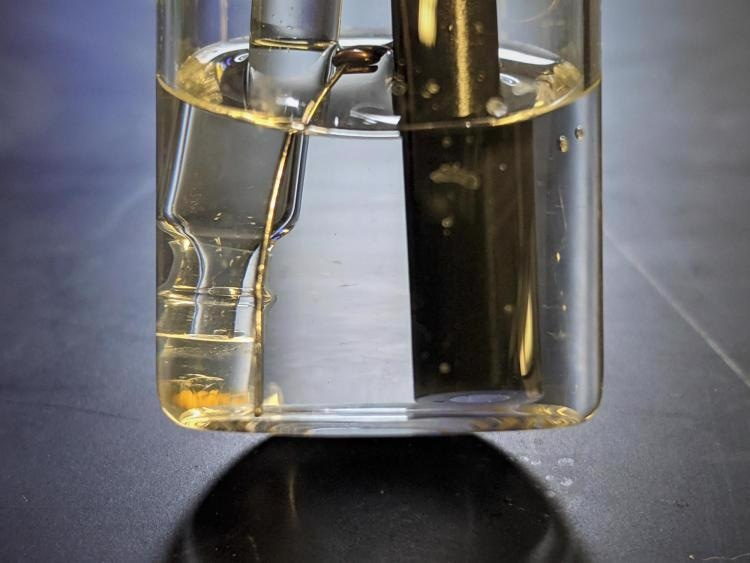Scientists at the University of Colorado Boulder have discovered a new device that could contribute to more efficient and cheaper methods of extracting heat-trapping gases from the environment and transforming them into useful substances such as fuel or construction materials.

Electrodes being used to activate molecular bonds. Image Credit: Haley Petersen.
Carbon capture technology of this type may be required on a large scale to keep global warming below 2.7 °F (1.5 °C) over pre-industrial levels this century and avoid the catastrophic impact of climate change.
The scientists demonstrate their method in a paper published today in the journal iScience.
The approach forecasts the strength of the link between carbon dioxide and the molecule that retains it, referred to as a binder. This electrochemical diagnosis can be implemented to any molecule that is chemically prone to interact with carbon dioxide, permitting scientists to explore potential molecular candidates for capturing CO2 from ordinary air.
The Holy Grail, if you will, is to try to inch toward being able to use binders that can grab carbon dioxide from the air [around us], not just concentrated sources. Determining the strength of binders allows us to figure out whether the binding will be strong or weak, and identify candidates for future study for direct carbon capture from dilute sources.
Oana Luca, Study Co-Author and Assistant Professor, Chemistry, University of Colorado Boulder
Carbon capture and storage devices aim to extract CO2 from the environment and securely store it for extended periods of time. However, despite the fact that it has been in operation in the United States since the 1970s, it only catches and stores 0.1% of global carbon emissions each year. Carbon capture and storage would have to expand rapidly in scale by 2050 to help reach the IPCC’s carbon emission goals.
Globally, current industrial facilities depend on extracting carbon dioxide from a concentrated source, such as power plant emissions. While these technologies may swiftly and effectively bind a significant amount of carbon dioxide using vast volumes of particular chemical binders, they are also extremely energy-intensive.
According to Luca, fellow-elect of the Renewable and Sustainable Energy Institute (RASEI), taking carbon dioxide and turning it into something valuable, such as carbonates, an element in cement, or formaldehyde or methanol, which may be used as a fuel, is also rather costly at scale.
Alternatively, using electrochemical technologies, such as those described in the new CU Boulder-led study, carbon capture systems would be untethered from concentrated sources, permitting them to operate practically anywhere.
According to Haley Petersen, co-lead author on the study and graduate student in chemistry, being able to quickly evaluate the resilience of chemical bonds allows researchers to monitor which binders will be ideal — and offer a cheaper alternative to traditional methods — for acquiring and transforming carbon into materials or fuel.
Creating Chemical Bonds
Chemistry is founded on a few fundamental principles: The first is that molecules are made up of atoms, and the second is that electrons orbit them. Molecules are formed when atoms link with one another. When atoms share electrons with other atoms, this is referred to as a covalent bond.
The researchers can trigger these bonds with electricity by delivering an electron to a molecule via an electrode. When a hydrogen atom is eliminated from an imidazolium molecule, as in this research, a gap in a carbon atom is created, allowing another molecule, such as carbon dioxide, to connect with it.
Carbon dioxide, on the other hand, is a molecule that dislikes forming new connections.
It’s generally unreactive, and in order to react with it, you also have to bend it. So we’re in a chemical space that hasn’t really been probed before, for CO2 capture.
Oana Luca, Study Co-Author and Assistant Professor, Chemistry, University of Colorado Boulder
The researchers used an electrochemical approach to test how effective a whole series of carbenes (a special sort of molecule containing a neutral carbon atom) were at capturing CO2.
Just by looking at very simple molecules—molecules that we can make, molecules that we can modify—we can obtain a map of the energetics for electrochemical carbon capture. It is a small leap for now, but possibly a big leap down the line.
Oana Luca, Study Co-Author and Assistant Professor of Chemistry, University of Colorado Boulder
This information is based on research funded by the National Science Foundation’s Graduate Research Fellowship program.
Journal Reference:
Petersen, H. A., et al. (2022) Predictive energetic tuning of C-Nucleophiles for the electrochemical capture of carbon dioxide. iScience. doi.org/10.1016/j.isci.2022.103997.